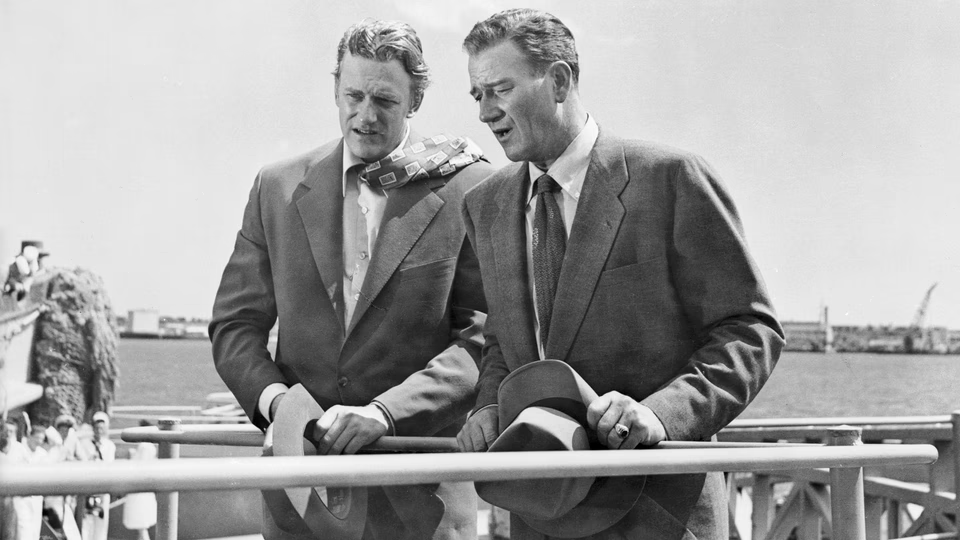Big Jim McLain

John Wayne’s first production under his Wayne-Fellows Productions company (later renamed Batjac) sees him playing a House UnAmerican Activities investigator ferreting out communists and romancing a war-widow played by Nancy Olson in Hawaii.
Said producing partner Robert Fellows upon announcing the company:
Our format is basically the same simple one that originally made our industry the greatest entertainment medium in the world. We start with a story that’s about something tangible. We’re not going to make outdoor dramas necessarily, but we do recognize the fact that film fans want to break through the confines of four walls when they are seeking entertainment.
We haven’t any tricks up our sleeves, nor do we have any dreams of collapsing all the major studios. On the contrary, our idea is to make money, a good deal of it, through offering the kind of entertainment that will lure people into the neighborhood theaters.1
Given this, Big Jim McLain seems an odd choice for a launch vehicle, as its anti-communist material proved controversial even in 1952, prompting Warner Bros. to flat-out lie about the story in its pre-shooting synopsis.2 Fellows later acknowledged Warner Bros. didn’t “wish to play up the fact that we were making an anticommunist film. The studio didn’t want to scare off exhibitors. A lot of them got burned in the past with anticommunist pictures that didn’t do much business.”3
Warner Bros. needn’t have worried, as the film turned a profit despite the critical panning.4 America was only eleven years removed from Pearl Harbor and still fighting in Korea. Wayne, like many other Americans, viewed Communists as the new Nazis. Assistant director Andrew McLaglen confirmed Wayne “believed in what the film had to say.”5
This earnestness proves a strength. Despite the film’s HUAC support landing on the wrong side of history, it never feels mean-spirited. You could take the same script and, with minimal changes, set it ten years earlier and have Wayne pursuing Nazi spies. Or do as they did in Italy, and change the title to Marijuana, and alter the dubbed soundtrack to have Wayne pursuing drug smugglers.6
But, regardless of their message, the script’s propaganda interludes feel out of place. An early scene has Wayne and his partner, played by James Arness, visiting the USS Arizona. The closing has a crew of cadets boarding a carrier, each turning to the camera and saying “Yo!” as they’re introduced. While effective morale boosters, these scenes feel pulled from a war film, not a police procedural.
Then there’s the matter of the Communists themselves. As villains, they underwhelm. Their most sinister plan seems to be sabotaging shipping by being poor workers on the docks. When they get serious and murder someone, it proves an accident, with the victim dying of an unexpected allergic reaction.
Indeed, the film’s difficulty in painting the Communist threat as black and white as the Nazi one weakens its proposition that the two are similar. Its union plot touches on how insidious such a threat could be but remains careful to avoid portraying unions as Communist.
Compounding matters, the production proves riddled with gaffes betraying the company’s neophyte status. While it maximizes the Hawaiian locales, background extras gawk at the performers during scenes, implying “stolen” shots filmed not with extras, but with real people. This proves less distracting than you might expect, as Wayne’s charisma proves strong enough that we’re so focused on him, we don’t notice everyone else looking at him. The spell breaks when it cuts to one of his costars, however.
Even the editing proves sloppy. One scene features Wayne and Olson atop the Nuʻuanu Pali. During a two-shot, Olson disappears, as the film cuts to the same shot featuring just Wayne, making it appear Olson blinked out of existence.
Despite these shortcomings, the film entertains. Seeing Wayne portray a contemporary investigator proves a welcome change, and he cuts a strong figure in his suits. His laconic demeanor and considerable charisma enable him to hold our interest despite the script and production problems. There’s even a running joke that Wayne’s ugly, which elicited chuckles.
Indeed, audiences would never have guessed the production coincided with the end of Wayne’s second marriage. Said Wayne, “It was a difficult time for me. The film was getting criticism from the do-good leftists before we’d finished filming, and at the same time, my second marriage was coming to an end.”7
One scene might offer a glimpse into Wayne’s inner turmoil. After getting some bad news, he heads to the city morgue. After emerging from a long dark hallway, he must identify a body. The film cuts to a closeup as Wayne delivers an angry voice-over bemoaning the death. The voice-over is passable but unnecessary. Wayne’s face says everything. A surprising bit of work that transcends the production and ranks among Wayne’s best.
Thus, for John Wayne fans, Big Jim McLain should entertain. Others should give it a pass, as without Wayne, the clumsy production and muddled script will prove difficult to overlook.
Notes
-
Scott Eyman, John Wayne: The Life and Legend (New York: Simon & Schuster, 2014), 226, Kindle. ↩︎
-
They said it was about a Texas cattle buyer who followed “a trail of excitement” to Hawaii. (Eyman, 2014, 227) ↩︎
-
Scott Eyman, John Wayne: The Life and Legend (New York: Simon & Schuster, 2014), 227, Kindle. ↩︎
-
A profit of $261,641. (Eyman, 2014, 228) ↩︎
-
Michael Munn, John Wayne (New York: Penguin Publishing Group, 2003), 143, Kindle. ↩︎
-
Scott Eyman, John Wayne: The Life and Legend (New York: Simon & Schuster, 2014), 228, Kindle. ↩︎
-
Michael Munn, John Wayne (New York: Penguin Publishing Group, 2003), 143, Kindle. ↩︎